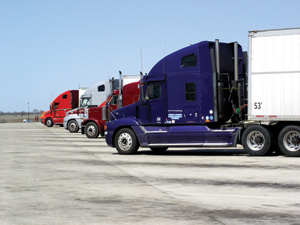Trucking towards Higher Efficiency

November 17, 2010
BY Erin Krueger
When it released proposed regulations to establish the nation's first standards to improve the fuel efficiency and reduce greenhouse gas (GHG) emissions of medium- and heavy duty vehicles, the U.S. EPA and U.S. Department of Transportation's National Highway and Traffic Safety Administration took a historic step towards putting more energy efficient diesel vehicles on U.S. roadways. The new regulations are an extension of similar requirements established for light-duty vehicles earlier in the year.
Although both RFS2 and the newly proposed regulations aim to reduce GHG emissions from transportation vehicles, the means to achieve those reductions are very different. RFS2 aims to reduce the GHG emissions through the use of renewable fuels, while the proposed GHG emissions and fuel efficiency standards seek to achieve reductions through greater vehicle efficiency via better engineering and design.
"We are proposing a strong and comprehensive national program that will oversee fuel efficiency standards for medium- and heavy-duty vehicles, whether pickups, vans, buses or semi-trucks," says DOT Secretary Ray LaHood. "This will be a win-win-win. It will reduce our reliance on oil, strengthen our energy security and mitigate climate change." Although the new proposed regulation affects both gasoline and diesel-powered heavy-duty vehicles, the impact on the diesel community will be far more pronounced. "More than 95 percent of all heavy-duty trucks are diesel-powered, as are a majority of medium-duty trucks," says Allen Schaeffer, executive director of the Diesel Technology Forum. "Diesel power is the driving force today of goods movement by truck in our economy. This proposal clearly envisions clean diesel power as the centerpiece of freight transportation in the clean energy categories of vehicles: combination tractors, heavy-duty pickups and vans, and vocational vehicles. Each of the three categories is further broken into several subcategories based on different elements, such as weight class, cab type, payload, towing capabilities, presence or absence of 4-wheel drive, or other identifying characteristics. Specific standards are designed for each applicable subcategory of vehicle.
EPA Administrator Lisa Jackson says, "Altogether, greater fuel efficiency will save Americans $41 billion, with the added benefit that much of the money will be able to stay at home in the U.S. economy rather than buying oil from overseas."
Although both RFS2 and the newly proposed regulations aim to reduce GHG emissions from transportation vehicles, the means to achieve those reductions are very different. RFS2 aims to reduce the GHG emissions through the use of renewable fuels, while the proposed GHG emissions and fuel efficiency standards seek to achieve reductions through greater vehicle efficiency via better engineering and design.
"We are proposing a strong and comprehensive national program that will oversee fuel efficiency standards for medium- and heavy-duty vehicles, whether pickups, vans, buses or semi-trucks," says DOT Secretary Ray LaHood. "This will be a win-win-win. It will reduce our reliance on oil, strengthen our energy security and mitigate climate change." Although the new proposed regulation affects both gasoline and diesel-powered heavy-duty vehicles, the impact on the diesel community will be far more pronounced. "More than 95 percent of all heavy-duty trucks are diesel-powered, as are a majority of medium-duty trucks," says Allen Schaeffer, executive director of the Diesel Technology Forum. "Diesel power is the driving force today of goods movement by truck in our economy. This proposal clearly envisions clean diesel power as the centerpiece of freight transportation in the clean energy categories of vehicles: combination tractors, heavy-duty pickups and vans, and vocational vehicles. Each of the three categories is further broken into several subcategories based on different elements, such as weight class, cab type, payload, towing capabilities, presence or absence of 4-wheel drive, or other identifying characteristics. Specific standards are designed for each applicable subcategory of vehicle.
EPA Administrator Lisa Jackson says, "Altogether, greater fuel efficiency will save Americans $41 billion, with the added benefit that much of the money will be able to stay at home in the U.S. economy rather than buying oil from overseas."
Advertisement
Advertisement
Advertisement
Advertisement
Upcoming Events





